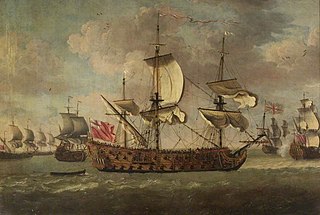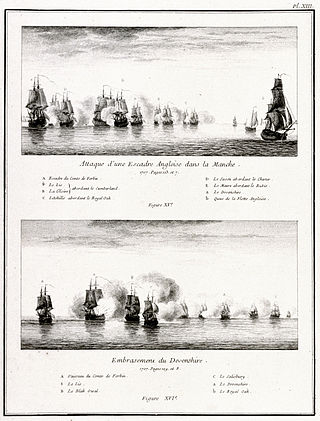The Treaty of Westminster of 1674 was the peace treaty that ended the Third Anglo-Dutch War. Signed by the Dutch Republic and the Kingdom of England, the treaty provided for the return of the colony of New Netherland to England and renewed the Treaty of Breda of 1667. The treaty also provided for a mixed commission for the regulation of commerce, particularly in the East Indies.

HMS Royal Oak was a 74-gun third-rate ship of the line of the Royal Navy, built by Jonas Shish at Deptford and launched in 1674. She was one of only three Royal Navy ships to be equipped with the Rupertinoe naval gun. Life aboard her when cruising in the Mediterranean Sea in 1679 is described in the diary of Henry Teonge.
HMS Cambridge was a 70-gun third-rate ship of the line of the Royal Navy, launched in 1666 at Deptford Dockyard.
HMS Greenwich was a 54-gun fourth-rate ship of the line of the Royal Navy, built by Christopher Pett at Woolwich Dockyard and launched in 1666.

HMS Charles was a 96-gun first-rate ship of the line of the Royal Navy, built by Christopher Pett at Deptford Dockyard until his death in March 1668, then completed by Jonas Shish after being launched in the same month. Her name was formally Charles the Second, but she was known simply as Charles, particularly after 1673 when the contemporary Royal Charles was launched.

HMS Falkland was a 50-gun fourth-rate ship of the line of the Royal Navy, built by Holland of New Castle, New Hampshire, and purchased by the navy in 1696.

HMS Swiftsure was a 70-gun third-rate ship of the line of the Royal Navy, built by Sir Anthony Deane at Harwich, and launched in 1673. By 1685 she had been reduced to a 66-gun ship.

HMS Oxford was a 54-gun fourth-rate ship of the line of the Royal Navy, built by Francis Baylie in Bristol and launched in June 1674. Her guns comprised twenty-two 24-pounders on the lower deck, with twenty-two large sakers (8-pounders) on the upper deck and ten smaller sakers (5-pounders) on the quarter deck.

HMS Woolwich was a 54-gun fourth rate ship of the line of the Royal Navy, built by Phineas Pett III at Woolwich Dockyard and launched in 1675. She underwent a rebuild in 1702.

President was a 38-gun fourth rate frigate of the Royal Navy, originally built for the navy of the Commonwealth of England by Peter Pett I at Deptford Dockyard, and launched in 1650.
HMS Reserve was one of six 40-gun fourth-rate frigates, built for the Commonwealth of England under the 1650 Programme, after the Restoration of the monarchy in 1660 she was incorporated into the navy of the Kingdom of England. She partook in no major Fleet actions during the First Anglo-Dutch War. After the Restoration during the Second Anglo-Dutch War she partook in the Battle of Lowestoft, the Four Days' Battle and the St James Day Battle. She spent the bulk of her service either in the Mediterranean or at Newfoundland. She foundered off Yarmouth in November 1703.
HMS Assistance was one of six 40-gun fourth-rate frigates, built for the Commonwealth of England under the 1650 Programme, after the Restoration of the monarchy in 1660 she was incorporated into the navy of the Kingdom of England. During her time in the Commonwealth Navy she partook in the First Anglo-Dutch war being present in the battles of Kentish Knock, Portland and The Gabbard. In the Mediterranean she was present at the Battle of Santa Cruz and the bombardment of Porto Farina, In the Second Anglo-Dutch War she was involved in the Battle of Lowestoft, Battle of Vagen and the St James Day Fight. She did not participate in fleet actions after this. She spent the rest of her service life undergoing several rebuilds and plying the waters as a cruiser protecting British trade and projecting British sovereignty. After nearly 95 years of Service she was sunk as a break water at Sheerness at the end of 1745.

HMS Salisbury was a 50-gun fourth rate ship of the line of the Royal Navy, built by Richard and James Herring at Baileys Hard on the Beaulieu River in Hampshire, England, and launched on 18 April 1698.

Newcastle was a 44-gun fourth-rate frigate of the English Royal Navy, originally built for the Commonwealth of England by Phineas Pett the Younger at Ratcliffe, and launched in May 1653. By 1677 her armament had been increased to 54 guns.

HMS Dover was a 40-gun fourth-rate frigate of the Royal Navy, originally built for the navy of the Commonwealth of England at Shoreham by William Castle, and launched in 1654. By 1677, her armament had been increased to 48 guns.

HMS Canterbury was a 60-gun fourth-rate ship of the line of the Royal Navy, launched at Deptford on 18 December 1693.

HMS Hampton Court was a 70-gun third-rate ship of the line of the Royal Navy, built at Rotherhithe according to the 1706 Establishment and launched on 19 August 1709.
HMS Sunderland was a 60-gun fourth rate ship of the line of the Royal Navy, built to the 1719 Establishment at Chatham Dockyard, and launched on 30 April 1724.

The Battle of Ronas Voe was a naval engagement between the English Royal Navy and the Dutch East India ship Wapen van Rotterdam on 14 March 1674 in Ronas Voe, Shetland as part of the Third Anglo-Dutch War. Having occurred 23 days after the signing of the Treaty of Westminster, it is likely to have been the final battle of the Third Anglo-Dutch War.
Wapen van Rotterdam was a Dutch East India Company East Indiaman that was built in 1666 for the Rotterdam Chamber of the VOC, and was operated from 1667, twice travelling to the Indies, until its capture by the English Royal Navy's frigate HMS Newcastle on 14 March 1674 in the Battle of Ronas Voe.












